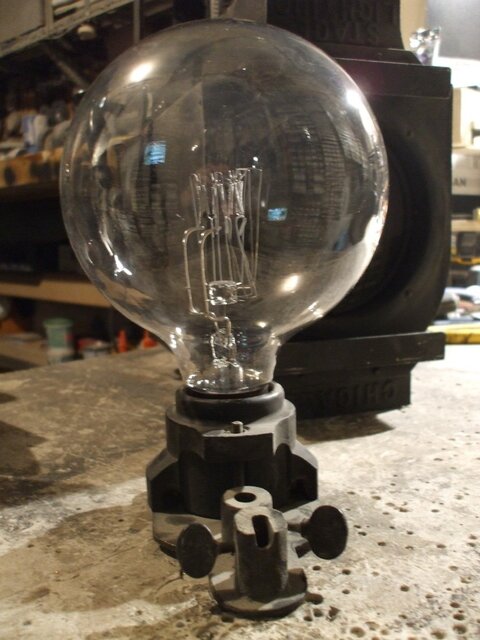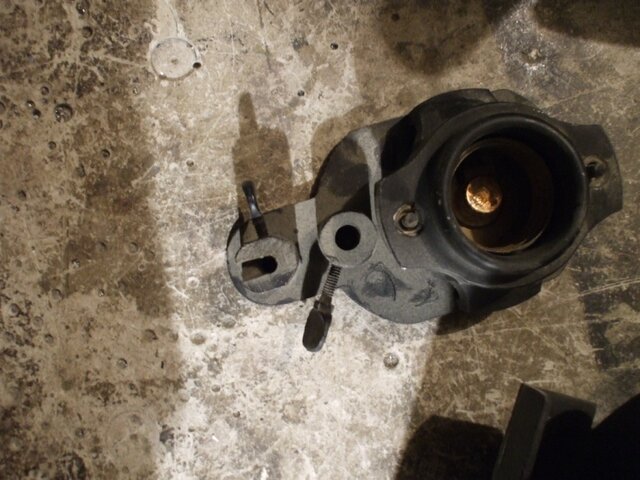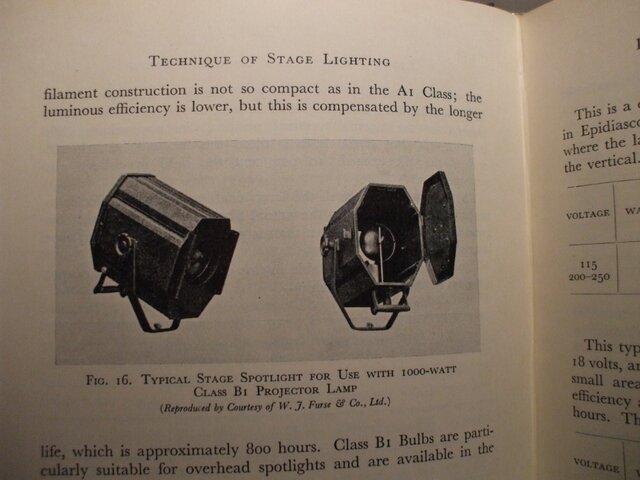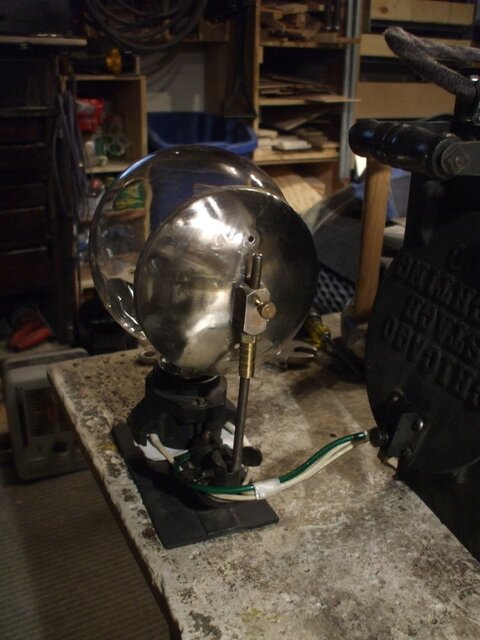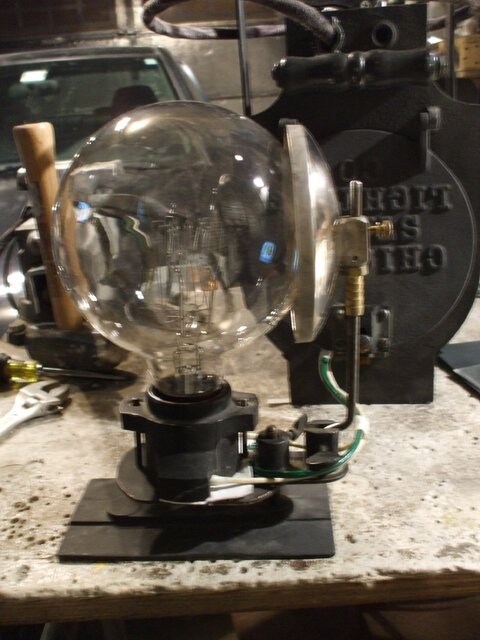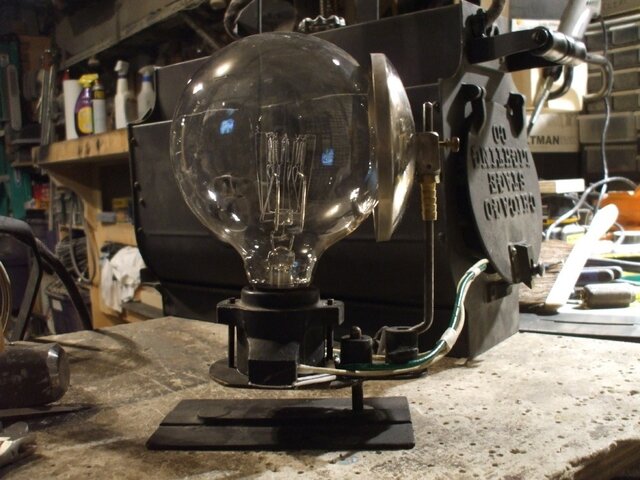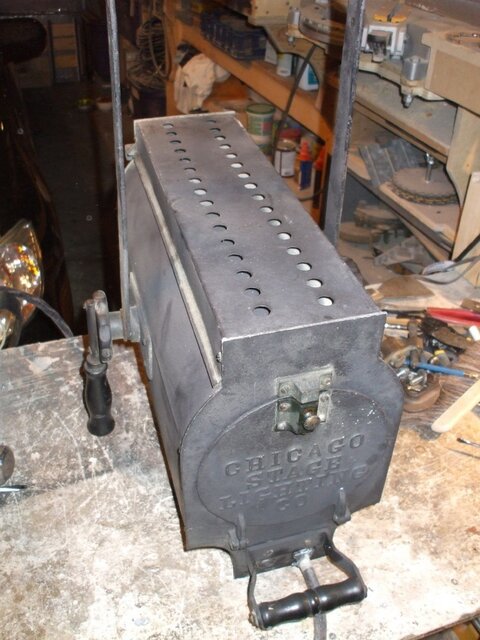In the past I posted about a 2Kw Chicago Stage Lighting 6" Plano Convex fixture I got for Christmas one year with it's lamp but without a rear reflector. Thought it possible given a simliar fixture w/o reflector, this one also never had one, now I think differently and it is a third class of Leko as it were.
Has a lamp base assembly as if some sort of science experiment stand. the base mount in the photo had a post mount closest to the lamp which mounts the socket & accessory bracket behind it. The center post bracket allows the base plate to orientate the lamp left/right and up and down. Thought it curious the second post mount with its slot but not used persay other than perhaps for an accessory reflector assembly.
Later I worked on a unknown brand of Fresnel and Mole #2046 Fresnel both also with rear access doors and noted the reflectors flipped down and out of the way to access the lamp. I'm thinking now this PC fixture was a 1930's Leko as it were possibly similar to what Kliegl introduced in the 1930's as with Fresnels back than. 3rd photo from p.28 of Rollo Gillespie Williams, F.I.E.S. 1960 text "The Technique of Stage Lighting." This is the type of reflector assembly that will have been mounted on the fixture.
[[[Next challenge is to install a 1/4" bronze pencil stock rod into the bracket, and more difficult get a ?Fresnel spherical reflector with rod bracket on its rear + possibly a base mount stop that perhaps indexes in a U-Shape to the flat spots on the base for alignment to the lens.]]]
On Page 55 of the book Gillespie also shows a photo of a classic wide lamp cap Century' brand "Ellipsoidal Reflector Spotlight" in addition to the "Spotlight" I photoed on page 28. He calls the one in the photo a "spotlight" though it looks like a PC or Profile to me. Old term. Both types of fixture were seemingly on the market at the time or publishing or at least still in use. Williams calls photo #3 I posted from page 28 a "Typical Stage Spotlight for use with Class B1 Projector Lamp" (Reproduced by Courtesy of W.J. Furse & Co. Ltd.)
[[The yoke knobs on the Chicago and Furse fixtures are also very similar - the Chicago has a bit less venting and shaping to it denoting perhaps an earlier fixture plus square nuts and round head screws, plus round head hot rivets which would not be done in the 1960's. This plus a wooden yoke knob extension handle that would be unknown in later deckades. My Major PC fixture fairly certain to be from about 1926 is very similar in also using the same type of manufacturing technique and hardware though not the yoke knob extension handle.]]
Interesting none the less because later in Frederuck Bentham's "The Art of Stage Lighing" 1968 text, p.77 shows a cut away photo of a "profile spot" and it's in reality a later era of radial Leko as it were. He also cites the year of invention of the Fresnel and "profile spot" (associated with the photo on the next page) to be Kliegl in the early 1930's.
By modern standards a "Profile Spot" I believe at least more considered to be a plano convex fixture and not a Leko type using a ellipsoidal reflector. Typical defination of a profile would be with spherical reflector or none at all as opposed to ellipsoidal reflector.
So assuming that an ellipsoidal reflector spotlight (or profile spot) was invented before 1960 but attributed on the page before a photo in the Betham book one can assume a "profile spot" is a ERS or "Leko", and given G-48 lamps often used in the 1920's and 30's plus a few deckades before the intruduction of say the pre-halogen T-20 lamp and mogul screw lamps were replaced somewhere in this time between 1930 and 1960 by the pre-focus base lamp such as the P-28s we have a problem of definition of fixtures.
Is there perhaps as a given some confusion between books but perhaps three proper classes of spotlights? Euro/American translations/terms asside.
Is perhaps plano convex or spotlight fixture without a reflector say a Plano Convex fixture, a PC fixture with a spherical reflector say a Profile Spot ( with a sliding lamp socket/reflector assembly) and a PC fixture (single or dual lens sliding lens assembly but not sliding base assembly) a "Leko" or Ellipsoidal Reflector Spotlight as long as it's using a ellipsoidal reflector?
Also, a ERS as indicated by Bentham certainly could not have been invented in the 1930's. Think about fitting the optical center of a G-48 lamp into a ellipsoidal reflector. The profile spot as a different class than a PC fixture must have been invented back than. The PC fixture was out in the 1920's and perhaps a few years before. Adding that reflector behind the lamp was probably really useful. And as in the case of many early Kliegl 4.5" PC or profile spot fixtures I worked with, the only difference between them and a Fresnel was distance of lamp to lens plus type of lens used, the rest was the same for all intensive purposes. Both fixtures had simlar reflectors.
Must have been a fascinating time between 1930 and 1960 for lighting fixture design. At some point in that period - most likely the early 1930's, the Fresnel came out. Also the Profile came out. Than following lamp technology, lamp globes were able to get smaller and bases more indexed accurate so one could than bring out the ellipsoidal reflector spotlight for much better control of the light beam and especially its stray light.
Still though, overall thought, is there three class of fixture based on the two books cited? Going to have a look at a few more from the period but I think during that period such a concept was not defined yet, and since than been washed over.
Following this, when did each of the three classes of Leko as it were come out?
Has a lamp base assembly as if some sort of science experiment stand. the base mount in the photo had a post mount closest to the lamp which mounts the socket & accessory bracket behind it. The center post bracket allows the base plate to orientate the lamp left/right and up and down. Thought it curious the second post mount with its slot but not used persay other than perhaps for an accessory reflector assembly.
Later I worked on a unknown brand of Fresnel and Mole #2046 Fresnel both also with rear access doors and noted the reflectors flipped down and out of the way to access the lamp. I'm thinking now this PC fixture was a 1930's Leko as it were possibly similar to what Kliegl introduced in the 1930's as with Fresnels back than. 3rd photo from p.28 of Rollo Gillespie Williams, F.I.E.S. 1960 text "The Technique of Stage Lighting." This is the type of reflector assembly that will have been mounted on the fixture.
[[[Next challenge is to install a 1/4" bronze pencil stock rod into the bracket, and more difficult get a ?Fresnel spherical reflector with rod bracket on its rear + possibly a base mount stop that perhaps indexes in a U-Shape to the flat spots on the base for alignment to the lens.]]]
On Page 55 of the book Gillespie also shows a photo of a classic wide lamp cap Century' brand "Ellipsoidal Reflector Spotlight" in addition to the "Spotlight" I photoed on page 28. He calls the one in the photo a "spotlight" though it looks like a PC or Profile to me. Old term. Both types of fixture were seemingly on the market at the time or publishing or at least still in use. Williams calls photo #3 I posted from page 28 a "Typical Stage Spotlight for use with Class B1 Projector Lamp" (Reproduced by Courtesy of W.J. Furse & Co. Ltd.)
[[The yoke knobs on the Chicago and Furse fixtures are also very similar - the Chicago has a bit less venting and shaping to it denoting perhaps an earlier fixture plus square nuts and round head screws, plus round head hot rivets which would not be done in the 1960's. This plus a wooden yoke knob extension handle that would be unknown in later deckades. My Major PC fixture fairly certain to be from about 1926 is very similar in also using the same type of manufacturing technique and hardware though not the yoke knob extension handle.]]
Interesting none the less because later in Frederuck Bentham's "The Art of Stage Lighing" 1968 text, p.77 shows a cut away photo of a "profile spot" and it's in reality a later era of radial Leko as it were. He also cites the year of invention of the Fresnel and "profile spot" (associated with the photo on the next page) to be Kliegl in the early 1930's.
By modern standards a "Profile Spot" I believe at least more considered to be a plano convex fixture and not a Leko type using a ellipsoidal reflector. Typical defination of a profile would be with spherical reflector or none at all as opposed to ellipsoidal reflector.
So assuming that an ellipsoidal reflector spotlight (or profile spot) was invented before 1960 but attributed on the page before a photo in the Betham book one can assume a "profile spot" is a ERS or "Leko", and given G-48 lamps often used in the 1920's and 30's plus a few deckades before the intruduction of say the pre-halogen T-20 lamp and mogul screw lamps were replaced somewhere in this time between 1930 and 1960 by the pre-focus base lamp such as the P-28s we have a problem of definition of fixtures.
Is there perhaps as a given some confusion between books but perhaps three proper classes of spotlights? Euro/American translations/terms asside.
Is perhaps plano convex or spotlight fixture without a reflector say a Plano Convex fixture, a PC fixture with a spherical reflector say a Profile Spot ( with a sliding lamp socket/reflector assembly) and a PC fixture (single or dual lens sliding lens assembly but not sliding base assembly) a "Leko" or Ellipsoidal Reflector Spotlight as long as it's using a ellipsoidal reflector?
Also, a ERS as indicated by Bentham certainly could not have been invented in the 1930's. Think about fitting the optical center of a G-48 lamp into a ellipsoidal reflector. The profile spot as a different class than a PC fixture must have been invented back than. The PC fixture was out in the 1920's and perhaps a few years before. Adding that reflector behind the lamp was probably really useful. And as in the case of many early Kliegl 4.5" PC or profile spot fixtures I worked with, the only difference between them and a Fresnel was distance of lamp to lens plus type of lens used, the rest was the same for all intensive purposes. Both fixtures had simlar reflectors.
Must have been a fascinating time between 1930 and 1960 for lighting fixture design. At some point in that period - most likely the early 1930's, the Fresnel came out. Also the Profile came out. Than following lamp technology, lamp globes were able to get smaller and bases more indexed accurate so one could than bring out the ellipsoidal reflector spotlight for much better control of the light beam and especially its stray light.
Still though, overall thought, is there three class of fixture based on the two books cited? Going to have a look at a few more from the period but I think during that period such a concept was not defined yet, and since than been washed over.
Following this, when did each of the three classes of Leko as it were come out?
Attachments
Last edited:



